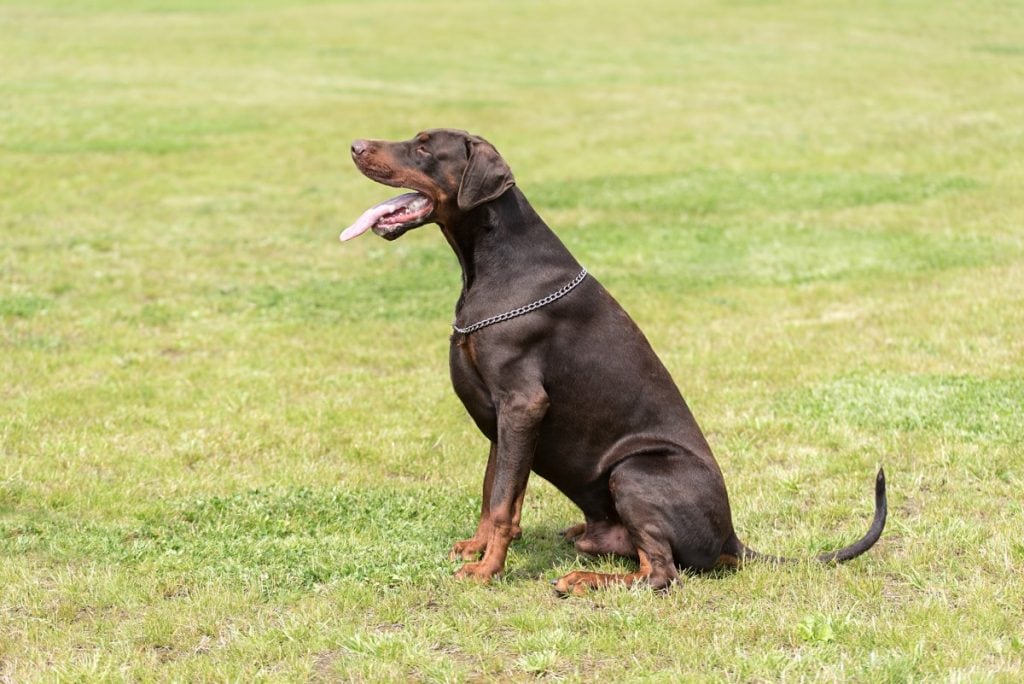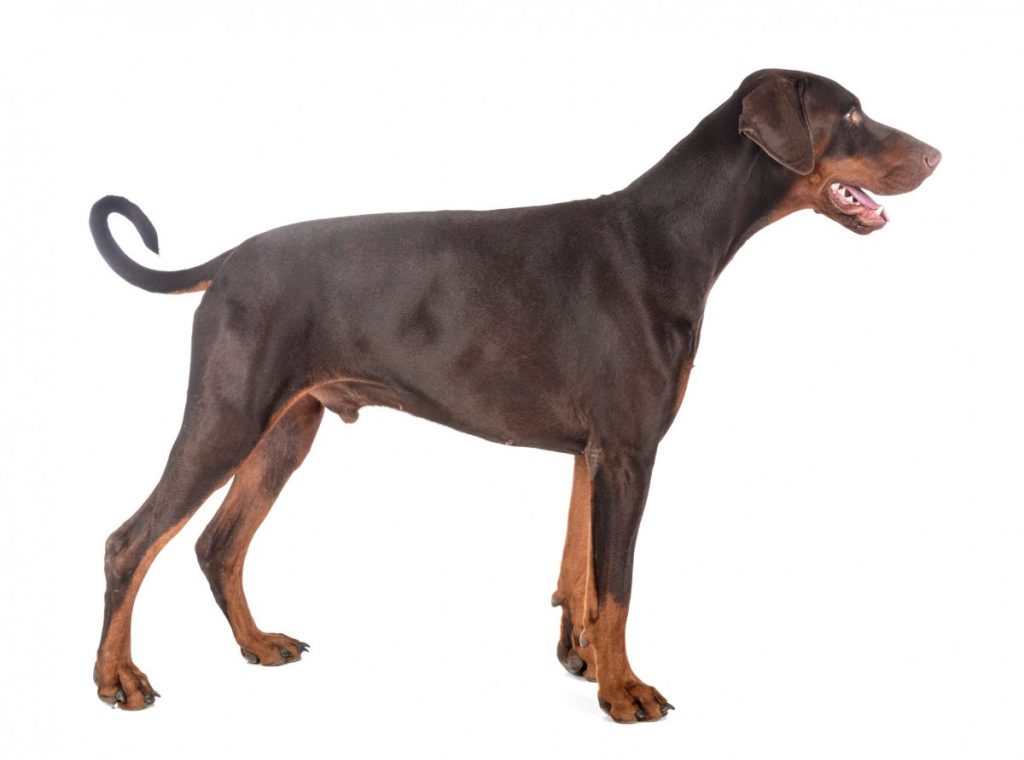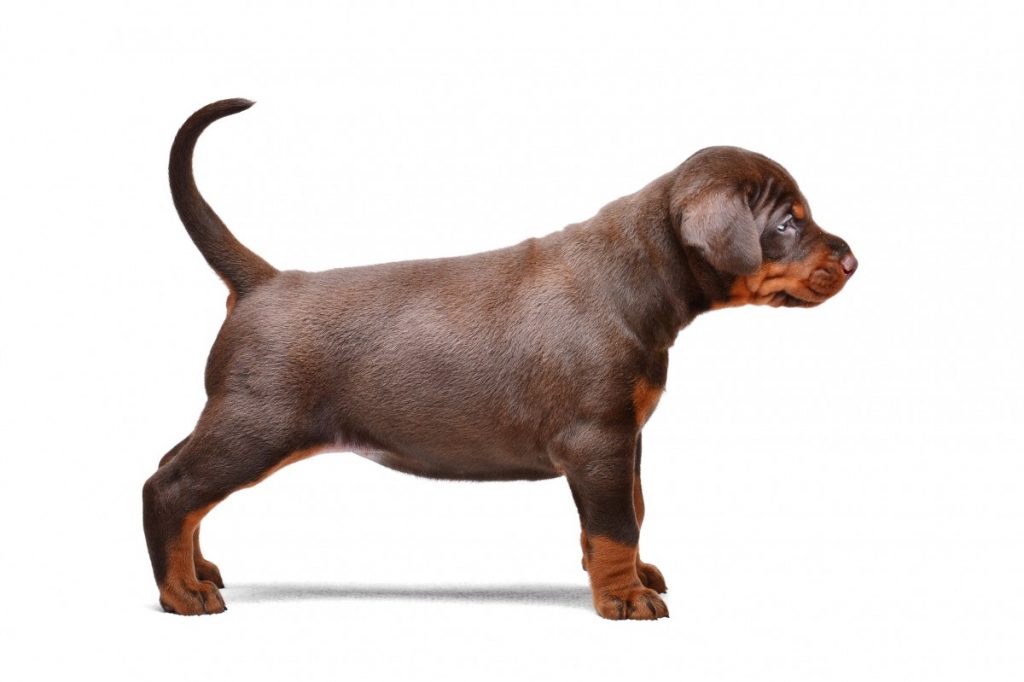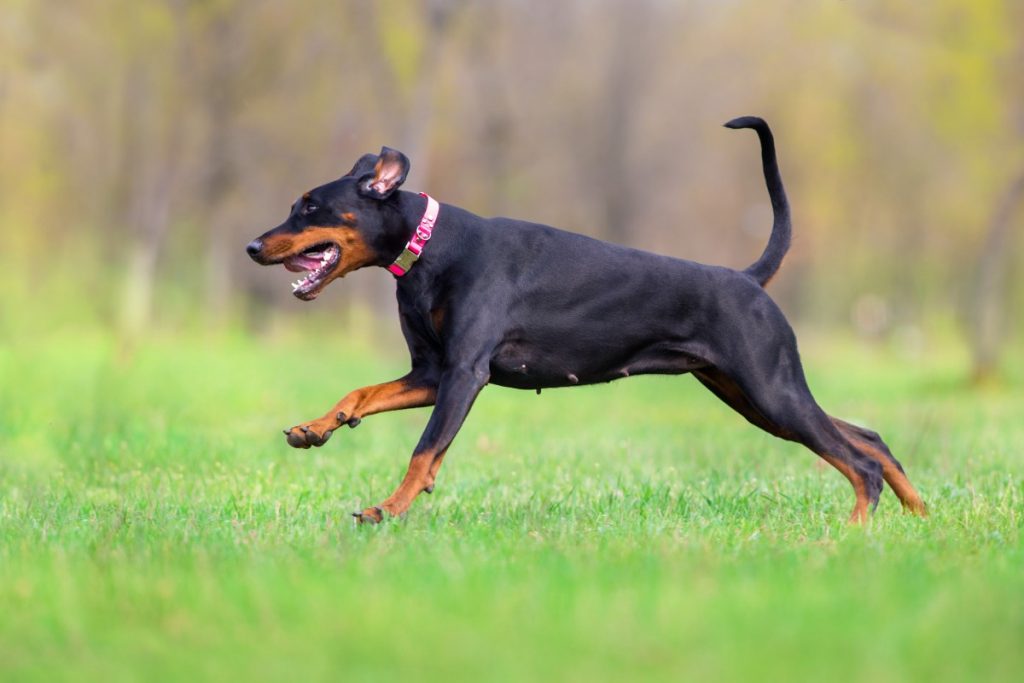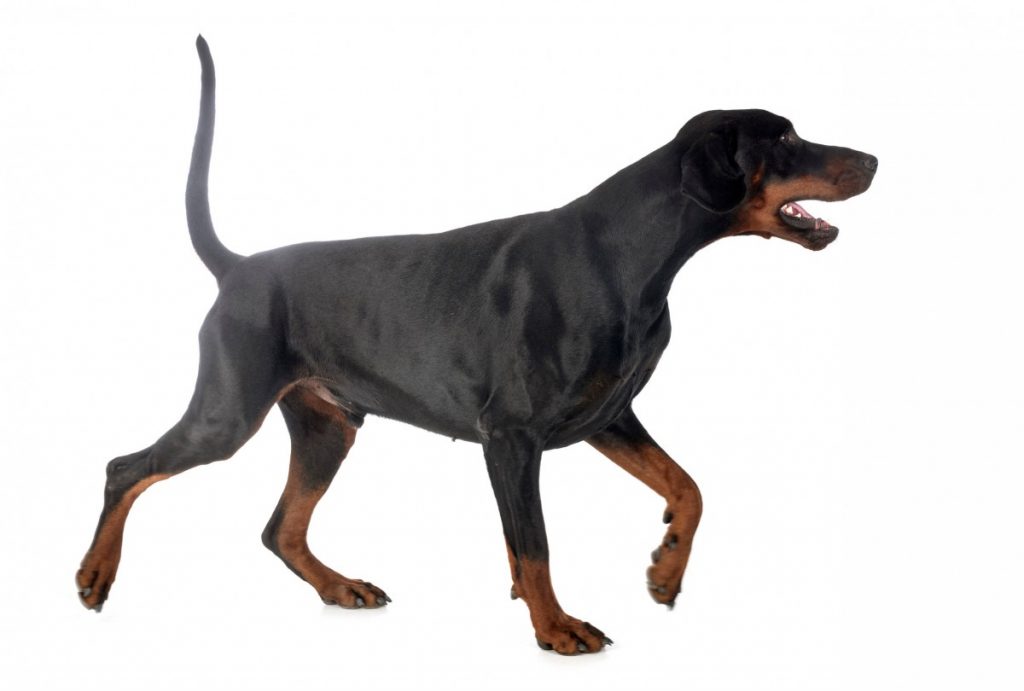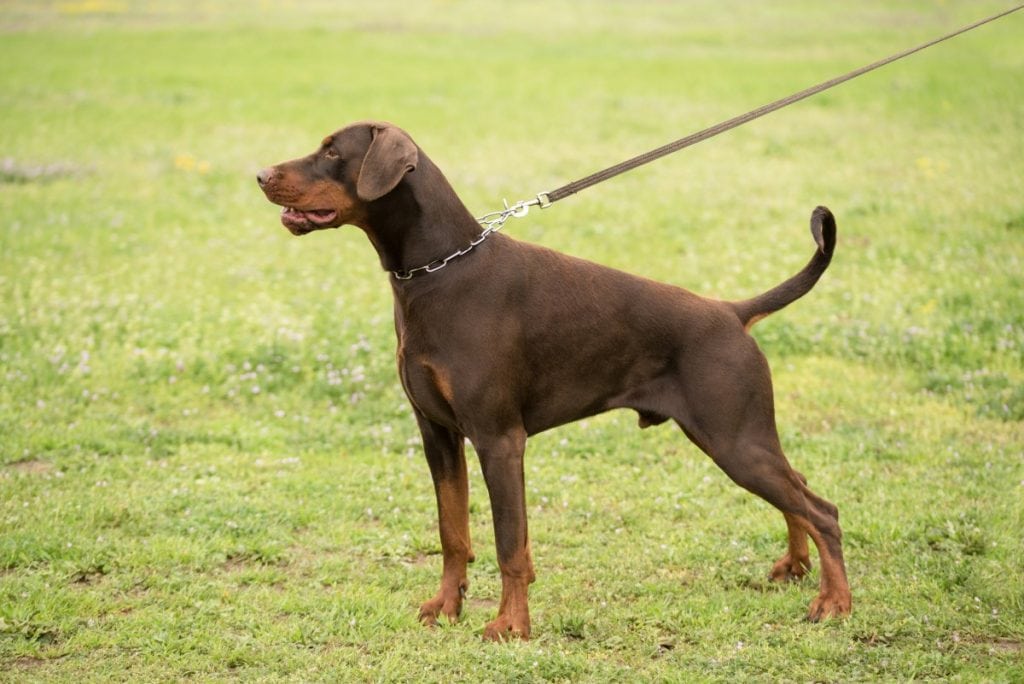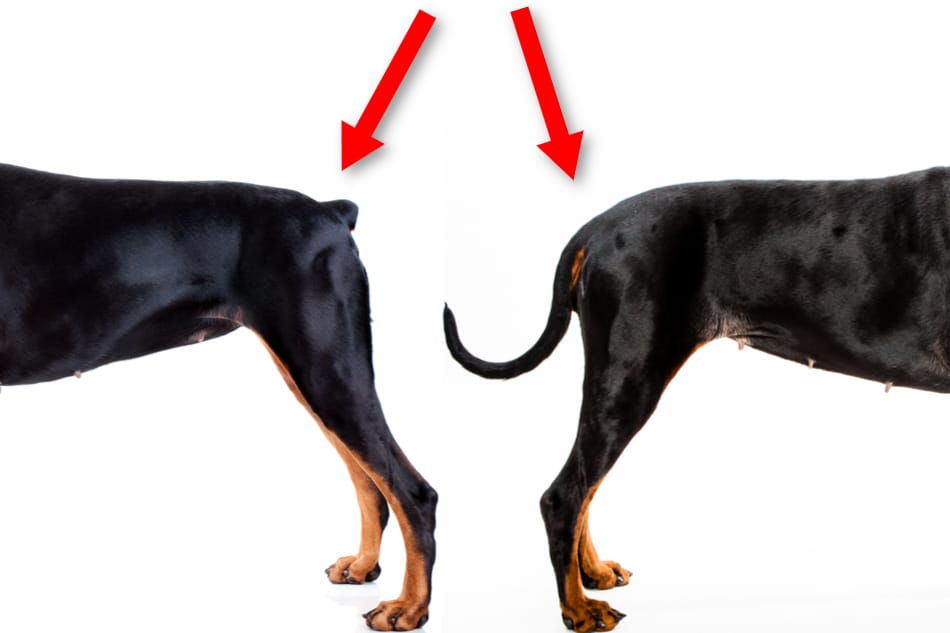
Dobermans traditionally have a tail that’s docked at about the second joint. However, long natural tails on these dogs are becoming more popular in recent years. Owners have a choice to make, should you dock your Doberman’s tail or leave it natural? It’s a simple question and after working with many clients as they raise their Dobermans, and speaking to Doberman experts, I think it’s clear that there are valid arguments on both sides of this issue.
Dobermans do not have to have their tails docked. While a Doberman with cropped ears and a short docked tail is the traditional look for the breed, there is no requirement that owners need to get their Doberman’s tail docked unless you plan to enter breed conformation shows.
Many people new to the Doberman breed seem to think that the only reason for getting their tails docked is for cosmetic reasons. When in fact, there are many more reasons than that. Whether or not the remaining arguments hold any weight with you personally, is another story. Here are the pros and cons to getting your Doberman’s tail docked.
Table of Contents
- Pros – The Arguments for Tail Docking
- Cons – The Arguments Against Tail Docking
- Video: Docked Tails vs. Natural Tails
- Legalities
- Cost
- Length
- Age
- Procedure
- Pain
- Tail Styles
- Natural Tail (Undocked) Doberman Pictures
- Position of the American Veterinary Medical Association (AVMA)
- Position of the American Kennel Club (AKC)
- Final Thoughts
- Related Questions
PLEASE NOTE: In this article, I will present the potential pros and cons of docking a Doberman’s tail by presenting arguments of those who are for and against it. The opinions and statements in the pros and cons sections in this article aren’t necessarily representative of the author’s opinions. They are presented here so you can make up your own mind.
Pros – The Arguments for Tail Docking
These are the potential benefits to getting your Doberman’s tail docked as most frequently argued by those who are for tail docking.
1. The Breed Standard
A breed standard is a document that outlines what the ideal example of a particular breed should be. Primarily, these documents are relied upon by breed conformation judges in the dog show circuit while evaluating dogs. There are two major breed standards for the Doberman.
The breed standard most used in the U.S. for the Doberman Pinscher, the AKC breed standard (available here), says:
“Tail docked at approximately second joint, appears to be a continuation of the spine, and is carried only slightly above the horizontal when the dog is alert.”
– Official Breed Standard of the Doberman Pinscher (The American Kennel Club)
The breed standard used in Europe, the Americas, Caribbean, Asia, Africa, and Oceania for the Dobermann (available here), says:
“The tail is left natural and is ideally carried high in a slight curve.”
– Federation Cynologique Internationale (AISBL) Standard No. 143 – Dobermann
The interesting thing about these breed standards when it comes to the tail is they are exactly opposite of each other. One requires a docked tail and the other requires a natural tail. Both consider it a fault to be outside their respective requirements.
Remember though that the breed standard only really matters if you plan to compete in breed conformation shows with your dog. The average household with a pet Doberman likely won’t be concerned with meeting breed standard requirements.
If you’re new to the Doberman breed, you can learn a lot of these basics by taking a look at the Complete Doberman Breed Overview here.
2. Easier Recognition as a Doberman
Inside the United States, a Doberman with a docked tail and cropped ears is so common that it’s actually extremely unusual to see one left in their natural state. In fact, it’s not uncommon for people who aren’t familiar with the breed to say they believe that Dobermans are born with short tails and upright ears naturally, as many have never seen a natural Doberman.
So when you leave your Doberman natural, it may get misidentified by people in public as a type of hound dog, mixed breed, or something else. Now, this can also be a benefit if you’re worried about the breed stigma that goes with the Doberman of being vicious, and want a dog who will be perceived as “softer”.
But being quickly identified also has other benefits, such as a deterrent for potential attackers, which bring us to the next point.
3. Better for Protection Work
The original reason Karl Friedrich Louis Dobermann docked the tails of his Dobermans was to help them excel at their original purpose, protection work. The Doberman’s naturally long, thin tail presented a weak point and it could be easily broken in a fight. It could also be used as a handhold to gain control of the dog by an attacker. Both of these could be solved by docking the tail.
Besides helping with their original purpose, protection of their owners, a docked tail will also help a would-be attacker identify the dog as a Doberman quickly and easily (see point 2 above). Even criminals know that the Doberman is very protective and fiercely loyal to their owners and most won’t want to challenge one if they realize the dog they’re confronted with is a Doberman.
A docked tail can help them identify the breed quicker and possibly prevent an incident before it even occurs simply because of the Doberman’s reputation.
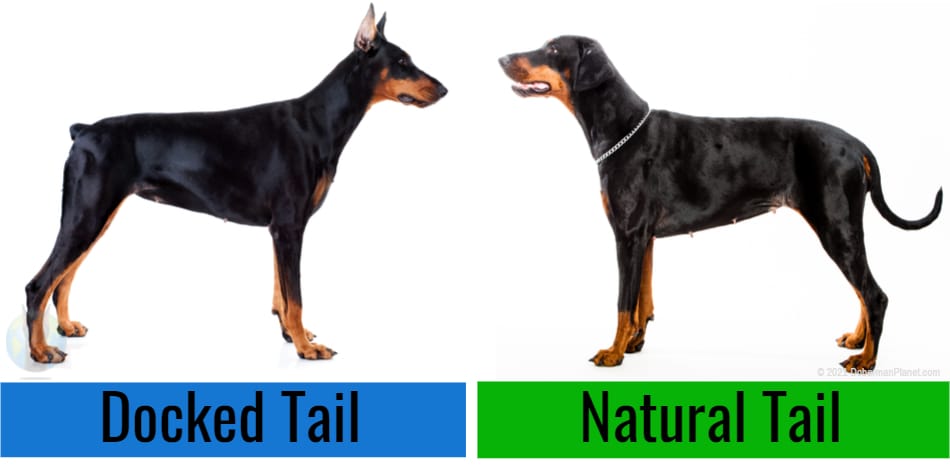
4. Prevents Future Injuries (Breakage)
A Doberman’s natural tail is long, thin, and dense. It can also break if it hits the coffee table too hard or the door frame as the dog sprints through the house. A broken tail on an adult Doberman is very painful and a vet will often recommend amputation if it occurs.
If the tail needs to be removed as an adult, it’s no longer a simple tail docking. It’s considered an “amputation” at that point and is now a serious procedure that can be painful for the dog. As a puppy that’s only a few days old (the typical time when a tail is docked), it’s not considered an amputation and is instead a simple procedure that arguably causes little or no pain.
5. More Practical in Daily Life
I’ve only ever owned Dobermans with docked tails but many owners who have owned both Dobermans with naturally long tails and short docked tails have told me that they much prefer docked tails for practical reasons. The long, dense, fast-whipping tail apparently has a tendency to smack kids hard in the face (causing tears), swipe drinks off of coffee tables, and cause other practical issues in daily life.
These things are made worse due to the fact that Dobermans are known for always wanting to be exactly where their owners are at all times.
6. Minimal Discomfort
The tails of Doberman puppies are docked when the dog is between 1 and 5 days old. Sometimes as late as 7 days old. When the docking is done at that young of an age, the nerve endings have not grown down into the tail yet meaning they likely won’t experience any pain at all. Tails are also not always simply cut off anymore, many breeders and veterinarians will simply wrap the tail in a tight band that will cause the tail to fall off in a few days.
In fact, one study on tail docking concluded the following:
“It may be concluded, therefore, that the initial absence of sufficient cortical-subcortical interactivity in puppies within 7 days of birth renders them incapable of consciously experiencing pain when tail docked at that age.”
– Animal Welfare Science and Bioethics Centre, School of Veterinary Science, Massey University, New Zealand (Source)
The same research study cited above also indicates that researchers were only “occasionally” able to detect feeling sensations being received by the puppy from their tails at 7 days after birth but that they weren’t fully neurologically matured (and able to feel pain completely in their tails) until between 14 and 28 days after birth.
7. Cosmetics
Lastly, many owners admit that they prefer the look of a Doberman who more closely resembles the “classic” Doberman Pinscher. Certainly, these dogs are known for their proud and stoic looks which many argue is enhanced with upright ears and a docked tail.
Other owners are also highly concerned with raising a Doberman in the image that was intended for the breed by the original creator of these dogs, Karl Friedrich Louis Dobermann. His early Dobermans had docked tails.
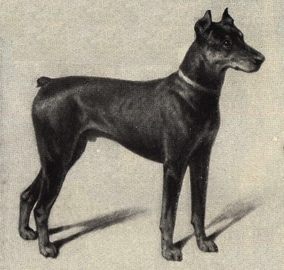
Cons – The Arguments Against Tail Docking
Below are the potential downsides, or cons, to tail docking as is argued by those who are against the continuation of this practice.
1. Unnecessary Pain and Discomfort
Removing a Doberman’s tail is almost never medically necessary, especially when it’s typically done (at only a few days old). Many see this as completely unnecessary and argue that cutting through skin, muscle, and cartilage is always painful for a dog at any age. Also, it’s unclear how many Dobermans actually experience a broken tail as an adult.
During a study done on the behaviors of puppies during the tail docking procedure, researchers made the following observation regarding the 50 tail dockings they observed:
“All puppies vocalised intensely (‘shrieking’) at the time of amputation of the tail.”
– Applied Animal Behaviour Science, Volume 49, Issue 4, 1996, Pages 335-342 (source).
Also, other studies have indicated that the dogs may experience ongoing increased sensitivity to pain in their tail stub or even phantom pains as an adult.
The issue of how much pain is felt is certainly still up for debate as there appears to be conflicting information. For example, many have argued that the “shrieking” that puppies do during tail docking is simply due to being pulled away from their mother and not from pain.
“Research shows that an intact tail is unlikely to become injured, and if it does, injuries are usually minor and heal easily.”
– James Serpell, PhD, director of the Center for the Interaction of Animals and Society at the University of Pennsylvania (source)
2. Reduced Communication
As someone who is certified in Canine Communication, I can tell you that Dobermans, like all dogs, use every part of their body to communicate how they’re feeling to other dogs and humans. Removal of one of the “tools” they use to communicate can lead to misunderstandings from other dogs especially, and the potential for additional conflicts.
These conflicts of course are not due to some inherent aggressiveness in the breed since Dobermans are not aggressive dogs, but instead simply due to a lack of an ability to communicate.
For example, in the dog world, a tail pointing up high to the sky is a sign of being alert (or a few other things like when they’re uncomfortable with a situation and squaring off with another dog). While a tail that is down will either indicate comfort or fear. These signals are impossible for your Doberman to give to others when they have a docked tail.
A study was done on the interactions of 431 dogs in the book “How To Speak Dog: Mastering the Art of Dog-Human Communication” by Stanley Coren, PhD and well-respected dog behavior researcher. Among those, 49 of the encounters included aggressive interactions. After examining how many of those aggressive interactions involved dogs with long tails and those with short (usually docked) tails, Stanley concluded that dogs without tails were twice as likely to have an aggressive encounter with another dog (source, p.g. 132).
3. Less Balance
A long tail is an excellent counterbalance while running, jumping, or performing complicated maneuvers. Some owners who prefer a natural tail are concerned about the loss of stabilization to the “vertebral column” and a loss of support to the back muscles with a docked tail.
Certainly, a dog with a docked tail can adapt with time, but it’s unclear how much and how this affects them as an adult. Many argue that not having a tail can interfere with a Doberman reaching their full potential with balance and agility.
4. Increase in Hernias
Docking a Doberman’s tail is thought to result in loss of some pelvic diaphragm muscles. This makes a certain type of hernia, called a Perineal Hernia, more likely to occur in these dogs. Perineal Hernias can appear on a Doberman’s rear end near their tail, are very uncomfortable for them, and require surgery to repair.
5. Urinary Incontenance in Females
Some studies have also shown an increased risk of urinary incontinence in female dogs who have had their tails docked (source). This has been shown to affect the Doberman breed more than many other dogs breeds out there (source). This is thought to have something to do with the effects that the docking procedure has on the integrity and functionality of the urethral sphincter.
The difficult thing here is that female Dobermans who are spayed also have a higher rate of incontinence so, at times, it’s hard for owners to determine exactly how big of a role tail docking has in any incontinence issues they’re seeing in their female dogs.
6. Trouble Defecating
The same study linked to in the previous section also indicates that interfering with the muscles in this area can also lead to negatively impacting the dog’s ability to hygienically defecate. I don’t know of any first-hand experiences shared by Doberman owners who indicate their dogs have problems defecating due to tail docking, but to be fair, it may not be obvious to an owner if their dog has lived most of their lives with a docked tail.
Video: Docked Tails vs. Natural Tails
Legalities
Tail docking is not legal everywhere, in fact, there are many countries that have outlawed this procedure either completely or except for working dogs or for medical purposes. The map below can give you a general idea regarding where it may be legal and where it may not be. Keep in mind, however, that this map may not be up to date.
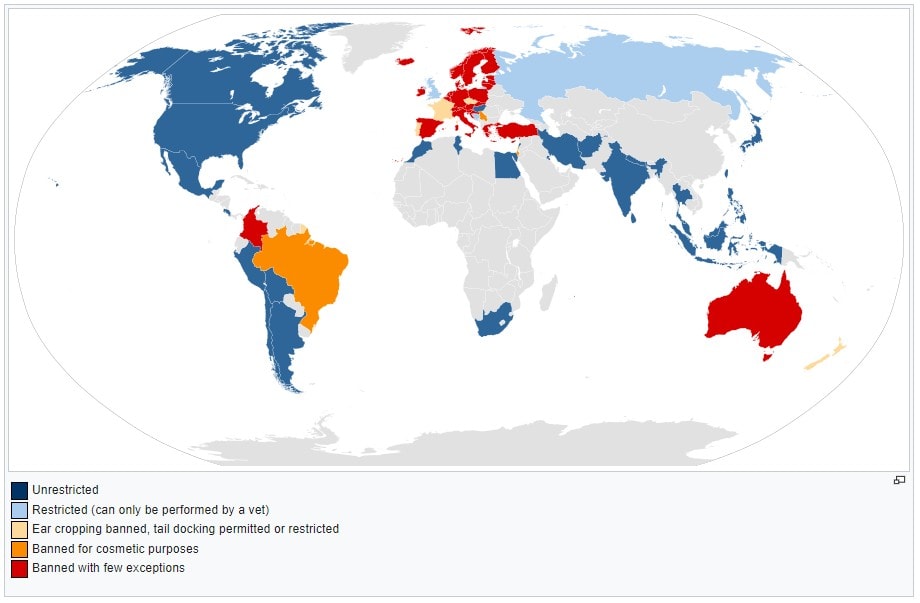
IMPORTANT NOTE: The map above may not be entirely accurate or up to date. It also may be misleading. For example, readers of this site have informed me that in Canada, tail docking is unrestricted on a federal level as indicated by this map, but is outlawed in most provenances. This is why it’s important to contact your local authority yourself and find out if it’s legal where you live.
In Australia and some parts of Europe, tail docking has been completely (or almost completely) banned. Therefore, the veterinarians in those countries do not perform tail docking procedures.
In the United States, some states, like Delaware, Maryland, and Pennsylvania, now restrict docking procedures. Pennsylvania restricts anyone other than a licensed veterinarian from docking a dog’s tail after it is five days old. Maryland restricts veterinarian tail docking to between five days and 12 weeks after birth unless medically necessary. Maryland law also requires that anesthesia has to be used during the tail docking procedure if appropriate, i.e., if the dog is old enough to feel pain and needs anesthesia to be comfortable for the procedure (source).
In most other areas of the United States, it’s legal for anyone to dock the tails of puppies at home without sterile equipment or anesthetic. Some experienced breeders are accustomed to doing this procedure themselves, but of course, it’s strongly recommended (and much safer) to bring your puppies to an experienced veterinarian.
Cost
We called veterinarians on both coasts of the United States and got quotes for tail docking of Dobermans specifically in an attempt to find out first hand what vets are actually charging and found the following: A tail docking procedure on a newborn Doberman puppy costs an average of $33.75 for a single puppy. The price can be as low as $4.57 per puppy if an entire litter is done at once. The price often includes dewclaw removal and it’s a 5 to 10-minute procedure that a veterinarian can usually do while the owner waits.
That’s for puppies, but some people do get adult Doberman’s docked for various reasons and since that is a much more involved procedure (it’s officially an “amputation” when they’re an adult), we found it costs significantly more.
A tail docking procedure on an adult Doberman costs anywhere between $525 to $815, with an average cost of about $600 depending on the dog’s weight and how much anesthesia is needed. This procedure usually involves dropping the dog off in the morning and picking them up at the end of the day.
This is just one of the many expenses that are involved with owning Dobermans. Luckily this expense isn’t usually seen by the eventual owner of the dog, only by the breeder. To see a complete ledger of the expenses involved with owning a Doberman, see the article How Much Does a Doberman Cost? Puppy Prices and Expenses.
Length
A Doberman’s natural tail is approximately 18 inches (45.7 centimeters) in length, measured from the base of the tail to the tip.
The length of a docked Doberman’s tail is not as straightforward as what their natural tail length is as it can vary a bit. However, luckily we have the breed standard to go off of for this. There are certainly some Dobermans who fall outside this standard, but it seems to be the most reflective of the average Doberman.
A Doberman’s tail should be docked at the second joint. The resulting nub will be approximately 2 to 3 inches long when they’re an adult.
The AKC breed standard indicates the number of joints of the tail that the dog should be left with, but not the length. That number has been made from real-world measurements.
Age
A Doberman’s tail is usually docked between 1 and 5 days after birth. However, it’s often done as late as 7 days after birth. It’s generally considered to be easier on the dog the earlier it’s done.
Although tail docking can be done on an adult Doberman, this is usually discouraged as it’s considered an “amputation” which is a serious procedure involving full anesthesia, a longer recovery, and more discomfort.
Procedure
The tail docking procedure on Doberman puppies is usually done using one of two methods.
- Banding Method – With this method, a rubber ligature (almost like a small rubber band or o-ring) is wrapped tightly around the tail of the puppy. The band constricts the blood flow to the tail which falls off in a few days.
- Surgical Method – This method involves removing the tail with surgical scissors or a scaple. Many times a small clamp is used to pinch the tail before it’s removed to prevent bleeding. After the tail is removed, either stiches or surgical glue are used to keep the wound closed.
This is typically done at the office of a qualified veterinarian, although there are some vets who will do this at the breeder’s home so that it’s not necessary to disturb the mother and her newborn puppies with a car ride to the vet. If done at a veterinarian’s office, the procedure is only 5 to 10 minutes and is typically done while the owner waits in the office. The owner can take the puppies home immediately after if there are no complications.
Pain
How much pain a Doberman experiences during the tail docking procedure, and afterward, is still open to debate. Many argue, and even some studies seem to confirm, that puppies at the age when a typical tail docking is done (1 to 5 days old) are incapable of experiencing pain in their tail area as nerve endings have not progressed down the tail yet, but they will as the dog ages.
For example, one study noted:
“…it may be concluded that nociceptive barrages caused by docking of puppies within 7 days of birth would not be consciously experienced as pain. Nevertheless, such docking seems likely to give rise to persistent pain experiences in the longer term at least in some individuals… consequences of tail docking within 7 days of birth likely include an ongoing heightened generalised sensitivity to pain (hyperalgesia).”
– Tail Docking of Canine Puppies: Reassessment of the Tail’s Role in Communication, the Acute Pain Caused by Docking and Interpretation of Behavioural Responses (source)
The study also says that something called “Neuromas” will form at the end of the cut nerves and that in humans, these are known to cause significant levels of chronic pain.
However, this same study offers an explanation as to why puppies may scream or “shriek” at the time of tail docking and it doesn’t have to do with the pain, but instead from other circumstances such as being pulled away from their mother for the procedure.
Another study titled “Behavioural observations of puppies undergoing tail docking” recorded detailed observations of 50 puppies that were undergoing tail docking and noted that all 50 of them “shrieked” at the time of amputation of their tail suggesting that they were experiencing discomfort.
See section 6 in the “Pros” section and section 1 in the “Cons” section in this article for more information on pain surrounding the tail docking of Dobermans.
Tail Styles
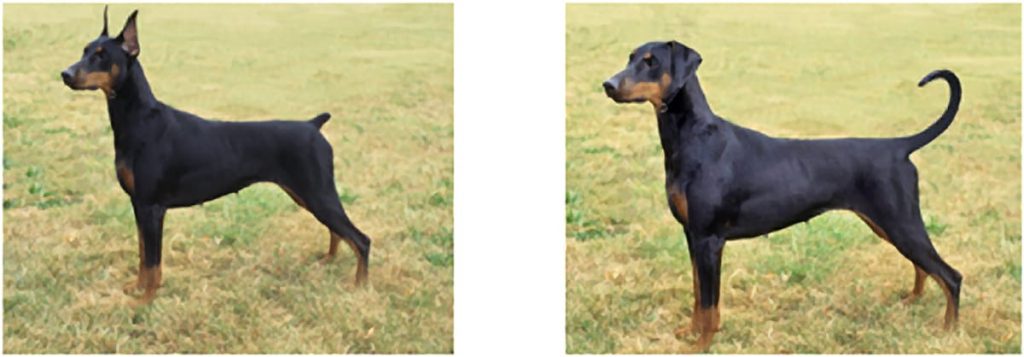
There are two styles of tail for a Doberman, docked or undocked (natural). A docked tail is a short nub about 2 to 3 inches long and an undocked tail is thin, dense, consists of a small curl, and is about 18 inches long.
A Doberman’s docked tail is docked at approximately the second joint and is usually 2 to 3 inches long as an adult, however, it can be longer or shorter depending on where the docking was done.
Natural tails seem to vary in length from as short as 15 inches to about 19 inches. These are very dense tails that curl gradually as you get near the tip. Some Doberman’s will have a more pronounced curl to their tail over others.
Natural Tail (Undocked) Doberman Pictures
Below is a photo gallery of various Dobermans with long natural tails. You can click on any image below to see a larger version of that image. These photos should give you a good idea of what Dobermans look like with natural tails and ears at various ages.
Position of the American Veterinary Medical Association (AVMA)
Veterinarians around the world have never really been in favor of tail docking. The American Veterinary Medical Association (AVMA) states that they began requesting that tail docking be removed from breed standards in 1976. They add, however, that while most of the world is opposed to tail docking, that there is less information regarding how veterinarians in the United States feel about it. The AVMA adds that there is very little scientific support to condone tail docking, even in working dogs.
Further, the AVMA clarified their stance on ear cropping and tail docking in the following statement:
“The AVMA opposes ear cropping and tail docking of dogs when done solely for cosmetic purposes. The AVMA encourages the elimination of ear cropping and tail docking from breed standards.”
– The American Veterinarian Medical Associationg (Source)
Position of the American Kennel Club (AKC)
The American Kennel Club (or AKC) has long been for docking the tails of certain working breeds. They believe that purebred dogs are “purpose-bred” dogs, meaning they were bred to fill a specific role. Many of these purebred dogs are working dogs and as such, at times a cropped ear and docked tail can have a valid working purpose.
The AKC’s policy on tail docking states the following:
“The American Kennel Club recognizes that ear cropping, tail docking, and dewclaw removal, as described in certain breed standards, are acceptable practices integral to defining and preserving breed character and/or enhancing good health. Appropriate veterinary care should be provided.”
– The American Kennel Club (Source)
The Ameican Kennel Club also released a statement regarding the American Veterinary Medical Association’s stance on tail docking that I mentioned in the previous section. In the statement, the AKC claims the AVMA was mislabeling these procedures as “cosmetic” and goes on to describe why they disagree with the AVMA’s stance on the issue. You can read their response to the AVMA here.
WHAT ABOUT EAR COPPING? Cropping a Doberman’s ears so that they’re short and pointing upwards is much more involved than tail docking. It’s also less common. To learn more about ear cropping, see my article on the pros and cons of Doberman ear cropping.
Final Thoughts
Is it cruel to dock the tail of a Doberman puppy? Or are you saving the puppy from injury later in life? This is certainly still up for debate. A Doberman’s signature attributes are upright, pointed ears and a short tail; such alterations have been made to Doberman puppies for over a century. However, simply because it’s tradition doesn’t mean it’s right. But it doesn’t mean it’s wrong either.
While the science might be far from settled, you should now have a good understanding of the arguments both for and against getting your Doberman’s tail docked and my hope is that you’ll be able to make a decision that’s right for you and your dog. A decision that you can be confident in.
Related Questions
Why do they cut the tail of a Doberman? Many Dobermans have their tails cut (or “docked”) to conform with breed standards, prevent future injury, enhance working abilities, or for cosmetic reasons. This is a controversial procedure as many argue it causes unnecessary pain and discomfort.
Are Dobermans born with tails? A Doberman’s tail is naturally between 15 and 19 inches long and usually consists of a slight curl. Their tails are thin, dense, and consist of a short single layer of course hair.

